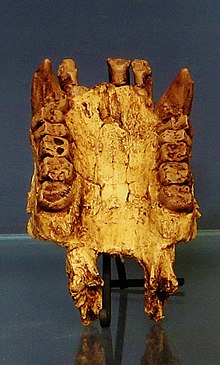Morotopithecus
| Morotopithecus Temporal range: Miocene,
| |
|---|---|

| |
| Jaw | |
| Scientific classification | |
| Kingdom: | Animalia |
| Phylum: | Chordata |
| Class: | Mammalia |
| Order: | Primates |
| Suborder: | Haplorhini |
| Infraorder: | Simiiformes |
| Family: | †Proconsulidae |
| Genus: | †Morotopithecus Gebo et al., 1997 |
| Species: | †M. bishopi
|
| Binomial name | |
| †Morotopithecus bishopi Gebo et al., 1997[1]
| |
Morotopithecus is a species of fossil ape discovered in Miocene-age deposits of Moroto, Uganda.
The phylogenetic status of Morotopithecus bishopi is debated to the extent that it challenges established views on the connection between Miocene primates and extant hominids (i.e. great apes).[2] Parsimonious phylogenetic analyses indicate Morotopithecus is more derived than Proconsul,[3] Afropithecus, and Kenyapithecus, but less derived than Oreopithecus, Sivapithecus, and Dryopithecus. Under this arrangement, Morotopithecus would be a sister taxon to extant great apes while Hylobates (gibbons) seem to have branched off before this clade appeared. However, gibbons are believed to have branched off 18 million years ago while Morotopithecus is dated to more than 20.6 million years.[4]
In a comparison of teeth characteristics of Morotopithecus to Afropithecus the results showed little difference, plus evidence gathered from cranial comparisons also indicate that the two genera may be the same, a conclusion of limited confidence due to the lack of evidence to produce a complete anatomy for both (Patel, Grossman 2005).[5] Meanwhile, Pickford (2002) referred the vertebrae to Ugandapithecus, and considered Morotopithecus synonymous with Afropithecus.[6]
References[]
- ^ D. L. Gebo, L. MacLatchy, R. Kityo, A. Deino, J. Kingston and D. Pilbeam. 1997. A hominoid genus from the early Miocene of Uganda. Science 276:401-404
- ^ Filler, Aaron G. (10 October 2007). "Homeotic Evolution in the Mammalia: Diversification of Therian Axial Seriation and the Morphogenetic Basis of Human Origins". PLOS ONE. 2 (10): e1019. Bibcode:2007PLoSO...2.1019F. doi:10.1371/journal.pone.0001019. PMC 2000357. PMID 17925867.
- ^ Maclatchy, L. (2004), The oldest ape. Evolutionary Anthropology: Issues, News, and Reviews, 13: 90–103. [1] doi:10.1002/evan.10133[Retrieved 2012-01-03]
- ^ Young, Nathan M; MacLatchy, Laura (2004). "The phylogenetic position of Morotopithecus" (PDF). Journal of Human Evolution. 46 (2): 163–184. doi:10.1016/j.jhevol.2003.11.002. PMID 14871561.
- ^ Biren A. Patel, Ari Grossman, (2005) Dental metric comparisons of Morotopithecus and Afropithecus: Implications for the validity of the genus Morotopithecus Interdepartmental Doctoral Program in Anthropological Sciences, Stony Brook University, Stony Brook, NY 11794, USA Journal of Human Evolution Volume 51, Issue 5, November 2006, Pages 506-512 Morotopithecus bishopi doi:10.1016/j.jhevol.2006.07.002[Retrieved 2012-01-03]
- ^ Pickford, M. (2002). New reconstruction of the Moroto hominoid snout and a reassessment of its affinities to Afropithecus turkanensis. Human Evolution, 17, 1–19.
- Prehistoric apes
- Miocene primates of Africa
- Fossil taxa described in 1997
- Prehistoric primate genera
- Miocene mammals of Africa
- Monotypic prehistoric primate genera



